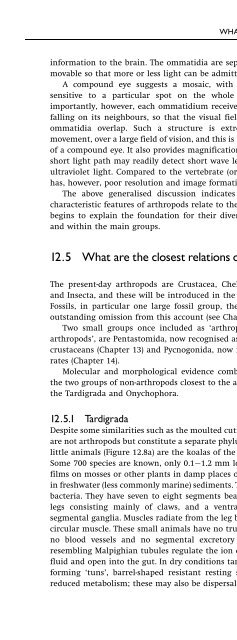An Introduction to the Invertebrates, Second Edition - tiera.ru
An Introduction to the Invertebrates, Second Edition - tiera.ru
An Introduction to the Invertebrates, Second Edition - tiera.ru
You also want an ePaper? Increase the reach of your titles
YUMPU automatically turns print PDFs into web optimized ePapers that Google loves.
WHATARE THE CLOSEST RELATIONS OF ARTHROPODS?165information <strong>to</strong> <strong>the</strong> brain. The ommatidia are separated by pigment,movable so that more or less light can be admitted.A compound eye suggests a mosaic, with each ommatidiumsensitive <strong>to</strong> a particular spot on <strong>the</strong> whole visual field. Mostimportantly, however, each ommatidium receives some of <strong>the</strong> lightfalling on its neighbours, so that <strong>the</strong> visual fields of neighbouringommatidia overlap. Such a st<strong>ru</strong>cture is extremely sensitive <strong>to</strong>movement, over a large field of vision, and this is <strong>the</strong> great advantageof a compound eye. It also provides magnification, and owing <strong>to</strong> <strong>the</strong>short light path may readily detect short wave lengths, for exampleultraviolet light. Compared <strong>to</strong> <strong>the</strong> vertebrate (or cephalopod) eye ithas, however, poor resolution and image formation.The above generalised discussion indicates that most of <strong>the</strong>characteristic features of arthropods relate <strong>to</strong> <strong>the</strong>ir exoskele<strong>to</strong>n, andbegins <strong>to</strong> explain <strong>the</strong> foundation for <strong>the</strong>ir diversity, both betweenand within <strong>the</strong> main groups.12.5 What are <strong>the</strong> closest relations of arthropods?The present-day arthropods are C<strong>ru</strong>stacea, Chelicerata, Myriapodaand Insecta, and <strong>the</strong>se will be introduced in <strong>the</strong> following chapters.Fossils, in particular one large fossil group, <strong>the</strong> trilobites, are <strong>the</strong>outstanding omission from this account (see Chapter 2).Two small groups once included as ‘arthropod-like’, or ‘pro<strong>to</strong>arthropods’,are Pentas<strong>to</strong>mida, now recognised as modified parasiticc<strong>ru</strong>staceans (Chapter 13) and Pycnogonida, now included as chelicerates(Chapter 14).Molecular and morphological evidence combines in identifying<strong>the</strong> two groups of non-arthropods closest <strong>to</strong> <strong>the</strong> arthropod ances<strong>to</strong>rs,<strong>the</strong> Tardigrada and Onychophora.12.5.1 TardigradaDespite some similarities such as <strong>the</strong> moulted cuticle, <strong>the</strong> tardigradesare not arthropods but constitute a separate phylum. These attractivelittle animals (Figure 12.8a) are <strong>the</strong> koalas of <strong>the</strong> invertebrate world.Some 700 species are known, only 0.1 1.2 mm long, living in waterfilms on mosses or o<strong>the</strong>r plants in damp places or between particlesin freshwater (less commonly marine) sediments. They feed mainly onbacteria. They have seven <strong>to</strong> eight segments bearing short lobe-likelegs consisting mainly of claws, and a ventral nerve cord withsegmental ganglia. Muscles radiate from <strong>the</strong> leg base and <strong>the</strong>re is nocircular muscle. These small animals have no t<strong>ru</strong>e coelomic cavities,no blood vessels and no segmental excre<strong>to</strong>ry organs; st<strong>ru</strong>cturesresembling Malpighian tubules regulate <strong>the</strong> ion content of <strong>the</strong> bodyfluid and open in<strong>to</strong> <strong>the</strong> gut. In dry conditions tardigrades survive byforming ‘tuns’, barrel-shaped resistant resting stages with greatlyreduced metabolism; <strong>the</strong>se may also be dispersal agents.











